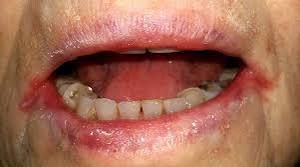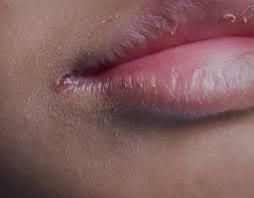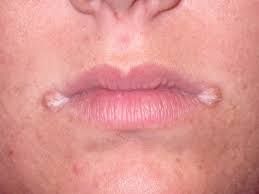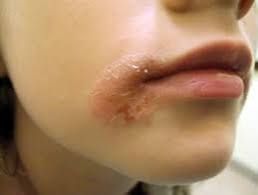Angular cheilitis is among the most expressed oral inflammatory condition, that affects the corners or commissures of the mouth. This post discusses its causes, symptoms, treatments regarding this oral condition.
Angular cheilitis is a localized inflammation that could occurs due to multiple reasons which is spotted at the corners of the mouth. It is usually expressed as red, swollen patches which may crack(break), bleed, or even cause pain.
Although it can be observed in people of all ages, there are certain conditions which make some individuals more susceptible to fall into the categories of patients suffering from this ailment.
As said earlier, other than other dermatological problems, angular cheilitis can arise from multiple triggers, which include infections, nutrient deficiencies, ill-fitting dentures or any habits that constantly irritate the lips. Timely diagnosis and treatment create fertile ground for faster healing and prevents discomfort that may come from being escalated to worst and advanced scenarios.
Common Causes of Angular Cheilitis
Getting prior and adequate identification of the causes is very instrumental to effective management and prevention of this inflammatory condition.
1- Fungal Infections
Candida albicans a very well known opportunistic organism often thrives well and express its presence in moist environments like corners of the mouth which may eventually lead to angular cheilitis.
2- Bacterial Infections
Staphylococcus aureus is a bacterium that has devastating effects on dermal structures, if a skin appears compromised, it can exacerbate the available symptoms.
3- Nutritional Deficiencies
Complete lack or inadequate quantity of vitamin B2 (riboflavin), iron, zinc and so can disrupt the skin’s capacity to exert quick healing or recovery from little cuts and thus increasing susceptibility to further infections and inflammatory response.
4- Dryness And Irritation
Excessive licking of lips and employment of some certain cosmetics, or even exposure to harsh weather situations can create an atmosphere for cracked skin which in turn promotes angular cheilitis.
5- Ill-Fitting Dental Appliances or Dentures
Dentures or braces which lacks proper fitting and has some degree of mobility can create folds on the oral mucosa where moisture accumulates, thereby fostering an ideal environment for infections to thrive.
Symptoms Of Angular Cheilitis
Recognizing angular cheilitis as early as possible assists in timely intervention and prevention further escalation of the condition. Common symptoms include:
i- Redness and swelling which is commonly observed at the corners of the mouth
ii- Cracked or split skin
iii- Painful sores which is prone to bleeding when opened or firmly touched
iv- Uneasiness in eating or speaking due to the discomfort obtained from the infection.
v- Formation of crusts or scabs on the areas in question.
vi- Itching or burning sensation might be reported to be around the lips
Risk Factors
Some categories of people are more open or to angular cheilitis due to some possible underlying factors. These include:
1- Age:
Old-aged people are often susceptible to experiencing angular cheilitis owing to reduced strength of immunity and poorly fitting dentures for edentulous patient
2- Immune Disorders:
Conditions such as HIV or diabetes or other conditions that can suppress the immune system can increase vulnerability to angular cheilitis.
3- Lifestyle Habits:
Frequent lip licking or smoking generally exacerbates irritation which can creates fertile ground for angular cheilitis.
4- Poor Oral Hygiene:
Negligence of proper oral care can bring about bacterial growth in the corners of the mouth which can eventually lead to infection and emergence of angular cheilitis
Diagnosing Angular Cheilitis
A dentist diagnoses angular cheilitis by undergoing physical examination and possibly laboratory tests for further confirmation.
Taking samples from the affected area through scrapping can assist a lot in determining if the infection is of bacterial or fungal origin.
Furthermore, in cases where nutrient deficiencies were suspected to be the cause, blood test sample might be taken for a through analysis of the implicated nutritional deficiencies and the patient is advised to take certain foods that contains them on regular basis.
Effective Treatment Options
A- Medical Treatments
Antifungal creams,gels, ointments and so on can prescribed to dislodge fungal infections which is caused by Candida albicans.
Antibacterial ointments should be employed if bacterial involvement is confirmed after thorough investigation.
Topical steroids should be used as adjunct treatment in case of delayed healing so as to reduce inflammation and promote healing process.
Vitamin Supplements is very critical in case of B vitamins, iron, or zinc deficiencies are suspected or confirmed.
B- Home Remedies or Non- Medical Remedies
Coconut Oil
It acts naturally as antifungal agents and soothes the skin for quick recovery.
Aloe Vera
It is observed that it provides anti-inflammatory which aim to reduce redness.
Petroleum Jelly
It helps in keeps the area moisturized, oily and protected against bacteria activities and infections.
Honey
It has antimicrobial properties which prevents further bacterial infections and accelerates healing.
Tea Tree Oil
Diluted tea tree oil aids in preventing infections and provides relief against any earlier irritation and painful symptoms.
Coconut Oil
It can also assists in keeping the area moisturised and provides a soothing relief.
In a nutshell, if there is no positive response or healing after about 7 days of home remedies use , a visit to an appropriate medical center is advised for immediate medical attention and intervention.
Tips For Preventing Angular Cheilitis
1- Maintain good and sound Oral Hygiene as it prevents bacterial accumulation and buildup
2- Always maintain regular water drinking and stay hydrated
3- Proper hydration prevents lips tissues from desiccation and drying out, thus reducing cracking.
4- Use protective lip products such as ointments and so on
5- Lip balms with with screen shield against harsh environmental condition and damage will go a long way in prevention of angular cheilitis.
6- Improving nutritional intake such as eating foods rich in vitamins B2, iron, zinc which can be found in vegetables such as edible green leaves, nuts, and some meats.
7- Adjusting ill-fitting dental appliances or dentures to avoid irritation.
7- Avoiding lip licking as salivary secretion can worsen dryness and promotes further inflammatory response.
Complications Of Untreated Angular Cheilitis
Neglecting angular cheilitis at the early stage maybe costly as it may result in persistent pain and further escalations, such as:
i- Chronic infections requiring extensive treatment and attention
ii- Permanent scarring
iii- Difficulty and uneasiness in eating and speaking owing to prolonged and severe pain.
"If symptoms persist beyond a week or worsen despite home care, seek medical advice. Persistent cases may indicate underlying health issues, such as diabetes or immune deficiencies, which need targeted management.
Angular cheilitis is a treatable condition that can cause significant discomfort if neglected. By addressing its causes and adopting preventive measures, you can reduce the likelihood of recurrence. Prioritize oral hygiene, maintain a balanced diet, and consult healthcare professionals when necessary to keep your lips healthy and pain-free."Source
That's all as regards the post on angular cheilitis. More on oral health to be discussed in the subsequent posts and happy reading.
Happy Blogging and Reading 💥💥💥💥
Video from Dr dray YouTuber



